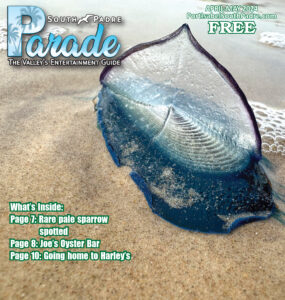By STEVE HATHCOCK
Special to the PRESS
In April of 1926, the Dallas News published a story about a proposed 5000 acre park to be located about halfway down Padre Island from Corpus Christi. Travelers would reach the park by driving along a road of hard-packed beach sand that would connect the north and south end of the island.
Shortly afterwards, the Gulf Coast Causeway Company was formally organized. Within the first year a hotel and more than a hundred cabins were built. Modern man had arrived…and in force.
Recognizing opportunity when he saw it, Sam resigned as Sheriff and organized the Brazos de Santiago Pass Ferry Company. The new company would provide ferry services to Padre Island to and from the piers at Brazos Santiago Pass, located across from the southern tip of the island while a second branch would run from Flour Bluff to Mustang Island in Nueces County.
Robertson’s other venture, the Ocean Side Toll Road Company, built a wooden causeway that connected Padre Island to the mainland near Corpus Christi. It was named “Don Patricio” after Patrick Dunn, the self-proclaimed “Duke of Padre Island.”
Robertson also planned a toll road, which he called, the Ocean Beach Drive, that would run along the beach from the mouth of the Rio Grande to Aransas Pass. On the southern end of the island, Robertson built an asphalt road and a hotel aptly named, “The Twenty-Five Mile Hotel,” also known as the Surf Side Hotel which he situated just north of where State Highway 4 ends on Boca Chica Beach. In addition, five houses were built about 45 miles north of the southern tip of the island while another was built almost three miles from the north end. Business was brisk. Robertson’s Ferry service carried visitors across Brazos Pass to a rickety pier that stretched out into a little inlet located on the extreme southern end of Padre Island. For the more adventuresome among them there was always the opportunity to reside a night or two in either the Casino Hotel or one of several fishing camps that occupied the lower end of the Island where Isla Blanca Park is now located.
An article, published in the Wednesday, November 2, 1932 issue of the Port Isabel Pilot notes an increase in tourism in that town too. “Dad” Coleman, a curio or souvenir shop owner whose hobby it is to list the out-of-state license plates he sees on the cars parked on the bay front, reported counting 106 cars bearing license plates from 23 states, the District of Columbia and Mexico, all parked within the confines of Powers and Maxan Street. (The Queen Isabella Inn was in operation then so it must be assumed many of the tourists spent their days on the Island trolling for shells or surf fishing only to return to civilization in the evening.) By all appearances, Padre Island was on its way.
But Robertson’ luck took a change for the worse when the Hurricane of 1933 struck at Boca Chica Beach wiping out his Del Mar resort. (This storm also caused much damage on Padre Island, partially destroying the Casino hotel and wiping out the fishing camps.
Borrowing heavily, Robertson began the task of rebuilding his dream. And for a while, it looked like the Colonel was going to make it. The April 11, 1934 issue of the Port Isabel Pilot contained a glowing report about the future of Del Mar Resort.
“The colonel says he will reopen the resort about April 15.” The reporter wrote, “There will be 26 new cottages ready for occupancy. The cottages this year will have every modern convenience including private shower and bath, and a telephone in each room.” Having learned from the destruction caused by the storm Robertson built his new cottages stronger, locating them above the storm tide line and bolting them to deeper, more secure foundations and using re-enforced walls and roofs A new dance hall and restaurant were also being built and the old bathhouse that came through the storm in pretty fair shape was quickly repaired. Over on Padre Island, the owners of the Casino Hotel, who had also rebuilt were pretty much full most of the time. The tourists were back in force. But it was too little and too late. The Great Depression bankrupted many and eventually it caught up to Sam.
Unable to retain his holdings, Colonel Sam sold his companies and all claims to Padre Island to Albert and Frank Jones out of Kansas City. Their luck was no better than Robertson’s and the brothers lost their shirts when another hurricane struck the mouth of the Rio Grande. The great storm destroyed most of the development on the southern end and wiped out Robertson’s wooden causeway to the north, Padre Island’s only connection to the mainland.
Robertson died on August 22, 1938, in Brownsville and was buried in Mission Park Cemetery, in San Antonio.
Want the whole story? Pick up a copy of the Port Isabel-South Padre Press, or subscribe to our E-Edition by clicking here.


Comments